
УДК 331.526
DOI 10.24411/2413-046Х-2019-18031
ПРОБЛЕМЫ ЗАНЯТОСТИ МОЛОДЁЖИ В РЕСПУБЛИКЕ АРМЕНИЯ
YOUTH EMPLOYMENT ISSUES IN THE REPUBLIC OF ARMENIA
Никогосян Марине Грандиковна, кандидат экономических наук, доцент, Армянский Государственный Экономический Университет (АГЭУ), г. Ереван, Республика Армения
Карапетян Лусине Вааговна, кандидат экономических наук, доцент, Армянский Государственный Экономический Университет (АГЭУ), г. Ереван, Республика Армения
Nikoghosyan M.H., grandmarine@gmail.com
Karapetyan L.V., l-karapetyan@hotmail.com
Аннотация: Целью исследования является изучение проблем занятости молодежи на рынке труда Республики Армения (РА). С этой целью мы провели социологические опросы среди 3840 респондентов с целью выявления причин высокого уровня безработицы среди молодежи, а также трудностей с доступом к рынку труда, их отношения к процессу найма, существующей дискриминации и факторы, влияющие на процесс принятия решений. Данные, предоставленные Статистическим комитетом РА в 1990-2017 гг., a также уровень экономической активности, занятости и безработицы среди людей в возрасте 15-29 лет, были использованы для изучения уровня занятости и безработицы в РА в 2010–2017-х гг. По результатам нашего исследования, которое было проведено в период с 20 июля 2018 года по 15 августа 2018 год, уровень безработицы среди молодежи составил 11,3%. 30,9% респондентов работают по профессиям, 26,2% из них в основном заняты по профессии, а 16,8% — имеют рабочие места, которые вообще не соответствуют их профессии. 66% молодых людей, которые хотят получить доступ к рынку труда, уже убеждены, что найти работу будет сложно. К сожалению, очень часто молодые люди в РА, имеющие профессиональное образование, становятся безработными или работают не по профессии, а также готовы выполнять любую работу для решения социальных проблем. После Бархатной революции в Армении в 2018 году у молодежи появились позитивные ожидания и стремления строить свое будущее на своей родине.
Summary: The aim of the research is to study youth employment issues in the Republic of Armenia (RA) labor market. For the above-mentioned purpose, we have conducted sociological surveys among 3840 respondents in order to identify the reasons for high level of unemployment among young people, as well as the difficulties to access the labor market, their attitudes towards the hiring process, existing discrimination, and the factors affecting the decision-making process. The data provided by the Statistical Committee of the RA in 1990-2017, as well as the level of economic activity, employment and unemployment among 15-29 years old people, were used to study the level of employment and unemployment in the RA in 2010-2017. According to the results of our survey that has been carried out during 20 Jul 2018 – 15 Aug 2018 time period, youth unemployment rate was 11.3%. 30.9% of respondents work by their professions, 26.2% of them are mostly employed according their profession, and 16.8%- have jobs, that do not correspond to their profession at all. 66% of young people, who want to have access to the labor market are already convinced that finding a job will be difficult. Unfortunately, very often young people in the RA, having vocational education, become unemployed or are employed to work not according to their profession, as well as they are ready to do any work to solve social problems. After Velvet Revolution Armenia in 2018 the youth has positive expectations and aspirations to build their own future in their own homeland.
Ключевые слова: занятость молодежи, рынок труда, безработица, работа.
Keywords: youth employment, labor market, unemployment, job.
Introduction
Social policy is a component of the country’s domestic policy that is developed by the state with the direct participation of various political forces and aims to solve the social issues existing in the country. One of the primary goals of social policy is to create appropriate conditions for the sustainable growth of the population’s income, which can be achieved through providing employment, increasing economic activity of the population, offering assistance to economically inactive population, raising qualification of labor force, ensuring competition and other means.
There are many problems in the RA labor market, including high unemployment, low wages, hidden employment, weak development of labor market infrastructure, weak application of financial leverage in labor market policy and wage inequality. The above-mentioned problems of the RA labor market are closely related to the processes taking place in the 1990s. After the collapse of the USSR, structural changes have resulted in changes in the structure of employment. Besides, the transition to market relations in the field of employment and labor resulted in fundamental changes in social and labor relations, particularly young people found themselves in difficult and hard situation, as from the social and psychological point of view they were not ready to face the new labor market demands [1].
The high economic growth in the 2000s did not lead to a significant expansion of employment as it was driven by productivity growth and structural changes in the economy. Particularly, the share of the construction industry grew dramatically, but the employment growth in this area took place as a result of decrease in employment in the industrial sphere [2]. The dynamics of the labor market development is conditioned by the general tendency of economic development and its typical periodic fluctuations.
Literature review
The future of each country is in the hands of modern youth. Young people are an exceptional resource of the productive power of the society, as they are not only active, productive, but also fast-learning productive force, besides they have contemporary mentality and at the same time they are the most vulnerable age group in the labor market [3]. Over the past decades, the RA youth labor market has been characterized by negative trends: the number of hidden unemployment among the youth, as well as its duration increases. Employment of young people is a complicated and actual issue as the demand for young workforce is not so high conditioned by the lack of work experience as well as the lack or complete absence of additional skills.
Groups of reasons for youth employment impossibility
In general, the following groups of reasons for youth employment impossibility are singled out [4]:
- the attitude of the employer towards the young specialist,
- qualification level discrepancy to the employer’s requirements (absence of independent decision-making experience,
- lack of knowledge in market economy,
- lack of practical skills in obtaining a profession),
- unreasonable perceptions of employment and workplace adaptation ways.
It arises in the choice of the future profession, and in future perspectives of employment and the majority of young people misperceive the idea of productive work ratings.
The term «young»
In the professional literature, the term «young» is interpreted in different ways, typically 14 to 30 years old people refer to this group [5], 16 to 30 years old people can also be considered young [6], and according to the UN age grouping, 14-25 age group [7]. An objective indicator of characterizing the youth age, which is used not only for theoretical definition of the given concept, but also for carrying out researches. Some researchers consider 11-25 years old people as young, whereas some up to 30 [8]. Such groupings are very conventional. Each age group, also 14-15, 16-17, 18-20, 21-24, 25-29, has social-labor adaptation peculiarities. Research shows that the lower the family income is the higher the family’s interest is to involve 14-15 years old young people in the labor activities, and in this case the family itself makes young people leave the study incomplete [9]. As a result an unqualified specialist enters the labor market. In this case, the young man’s work prospects are not satisfactory. Thus, the state should develop programs, which can allow young people to work and study at the same time.
Conditions to be regarded as busy in the RA
According to Statistical Committee, people engaged in the Armenian weekly survey are considered busy in the RA [10], if
• they have performed hired or non-hired work, no matter the work has been permanent, temporary or seasonal, occasional or accidental, even if that job was only for an hour during the surveyed week,
• they have been temporarily absent from work for various reasons,
• they have been engaged in household or farming, and the output was intended for full or partial sale or exclusively for their final consumption, if that product had a significant share in household consumption.
Types of employment activities
According to the RA Law on Employment adopted in 2013, the employment includes the following types of activities not prohibited by the RA legislation [11]:
• hired labor activity of employers (including being in the staff reserve of the services provided by the laws of the Republic of Armenia, except for cases not requiring remuneration),
• providing services or performing work under civil law contract,
• private entrepreneurship and notary activities,
• the activity of the patent payer,
• compulsory military service,
• training in educational institutions, vocational training courses and other forms of learning.
The socio-economic essence of employment
Employment is not just any activity; it is also a process that satisfies personal and public needs [12]. The socio-economic essence of employment is that it is not only one of the most important macroeconomic indicators and is not only a source of income, but also people’s social need to do a public-friendly job with relevant qualification.
Main goals of RA state employment policy [13]:
- to create conditions for the provision of stable employment, implemented through state regulation of the economy and social protection of the population;
- to ensure the labor force demand of necessary quantity and quality;
- to guarantee internationally accepted standards of decent work;
- effective realization of the current supply of labor as the component of the economic policy;
- consistent provision of the conditions, identifying competitiveness in the labor market
- ensuring effective inclusion as a part of the social protection policy.
Conditions to be regarded as unemployed
According to the current legislation of the Republic of Armenia, people are considered unemployed (officially registered), if they are able to work, but are currently unemployed or are looking for a job and are not eligible for retirement benefits (except for the types of retirees in case of losing the bread-winner), are registered in the State Employment Service, are willing to work and have received unemployment status. And according to the standard definition of the International Labor Organization (ILO), unemployed are considered to be those, who have at the same time satisfied the following conditions during the survey period [14]:
• did not have a job or a lucrative business,
• have been actively seeking for a job in any way possible during the last four weeks preceding the observed period,
• were ready to start working within two weeks.
Annual state employment programs
State regulation of population employment in the Republic of Armenia is implemented through annual state employment programs. It focuses on:
- mitigating labor market tensions;
- promoting sustainable employment and self-employment for unemployed people in the labor market through active employment programs;
- promoting employers’ involvement in job creation, especially for people with disabilities;
- increasing the level of youth employment, sustainable employment state programs;
- integration of vacancies with qualified specialists;
- ensuring effective and sustainable employment of not competitive groups in the labor market within the framework of social service provision [15].
The low level of employment opportunities for young people entering the labor market for the first time, the high level of informal employment in Armenia, the organization of vocational training at the employer for young mothers, who are unemployed and unskilled in the labor market are among the issues highlighted for 2018. The program outlines the provision of support for unemployed women up to 24 years with higher education, as well as providing assistance to people on parental leave for under three years old baby, supporting to organize the child’s care along with the work in case of returning to work before the child turns two, etc.
Methodology
The primary data collected as a result of both secondary and sociological surveys were the basis for the survey. Primary data were collected by e-mail inquiry method, Laikert’s 5-point scale was used in the questionnaire (1: the least important, 5: the most important): Factor and cluster analysis methods were used for primary data analysis.
The sample was implemented within the framework of the youth aged 15-29 (655900 people, according to Statistical Comittee of RA) [16] and involved 3840 respondents, with 5% sampling error and 95% confidence interval. 57% of respondents are females, 43% are male, 11.3% of them are unemployed, 45.6% are employed in different sectors of the economy, 22.9% both study and work, and 20.2% are busy only with studying. 28.6% of respondents are married. The average monthly income of employed youth is around $ 302.7). The secondary sources were collected by statistic reports, websites and articles. The 2010-2017 time periods was utilized for the economic activity rate and 1990-2025 for employment and unemployment rates.
Result and discussion
- Employment rate in Armenia
In 1990-2017, the employment rate in Armenia sharply declined from 80.3% to 50.1% (tab. 1). We considered the age group of 15-29 to study youth employment problems in Armenia so that we can use secondary data from the Statistical Committee of the Republic of Armenia publications as well.
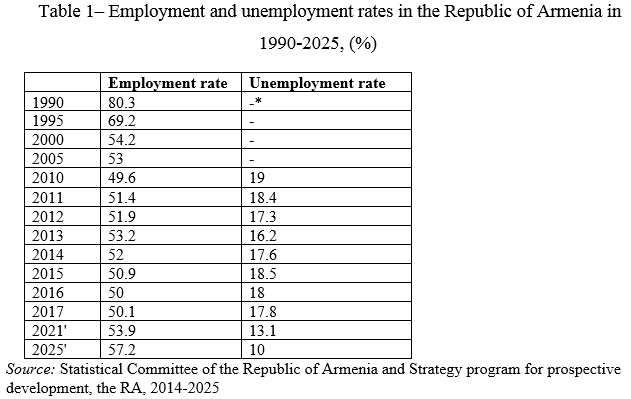
From the point of view of studying the labor market in Armenia, 15-75 is considered the working age [10].
According to Statistical Committee of RA, the unemployment rate in Armenia was 17.8% or 219 thousand people in 2017, of which the younger age group had the highest per centage of age, so the age group of 15-19 was-9.1 thousand, in the age group of 20-24 was 37.6 and in the age group of 25-29 was 31.8 thousand [1].
Level of youth’s economic activity
The stable high level of unemployment is a negative signal for being successful in trying to find your place in the market, which, naturally, directly affects the level of labor force participation. At the same time, large amounts of labor migration and cash received from these migrants raise the minimum reservation wage of their family members remaining in the homeland, in this case they will agree to work. This also has its negative impact on the level of economic activity in the labor market. The level of youth’s economic activity, employment and unemployment in Armenia is presented in Table 2.
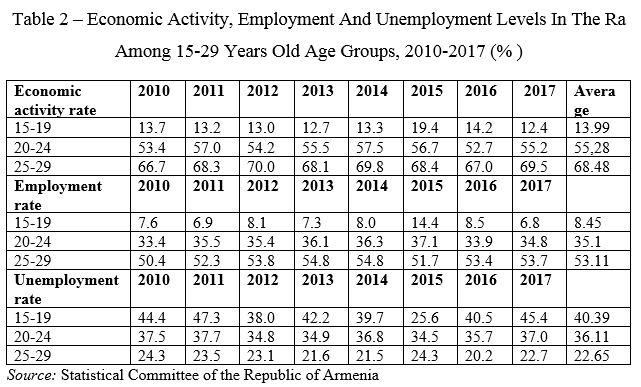
Table 2 shows that in 2010-2017, the highest level of economic activity was registered in the 25-29 age group, with an average of 68.5%. In the 15-19 age group, the average annual economic activity was 14.%. Moreover, the highest rate was recorded in 2015, 19.4%, which was 6.1 per centage points higher than in 2014, and by 2017 it dropped by 7%. An average of 20-24 years old age group was 55.3%. In 2010-2017 in the 25-29 age group, the average employment rate was about 53%, in 20-24 age group — 35.1%, and in 15-19- 8.5%. The highest unemployment rate is registered in the 15-19 age group- 40% on average, which is conditioned by the fact that in Armenian families the primary importance is given to education and, in the first years of studying in the university, young people are mostly busy with studying, while the family takes care of their expenses. However, the unemployment rate in the 20-24 age group leaves room for worrying with 37% in 2017, which was only 0.5 percentage points lower than in 2010. The respective index for 25-29 age group was 22.7 per cent on average.
According to preliminary data, based on our choice (3840 respondents):
- 11.3% of Armenian youth are unemployed,
- 45.6% are employed in different sectors of the economy,
- 22.9% both study and work,
- 20.1% is only busy with learning.
- 29.8% of the employed youth are engaged in trade, repair, transportation and storage, hotel and public catering,
- 25.1% in financial and insurance companies,
- 12.7% in public administration and education,
- 2.2% self-employed 1.8% are engaged in agriculture and industry,
- 15.3% are doing other jobs.
- So, in the 15-19 age group — about 1.5% of the respondents are employed,
- in the 20-24 age group — 61.2%,
- in the 25-29 group — 37.3%.
It is clear that the youngest 20-24-year-olds constitute the largest percentage of employed people.
2. Compliance with the specialty
In response to the question, «Whether the current employment of young people correspond to their profession,» we have the following: (fig. 1), 30.9% of questioned working youth work by their profession, 16.8% of them have jobs not corresponding to their profession, and 26.2% are mostly employed according to their profession. In case of complete professional discrepancy, young people are involved mainly in trade, repairs, transportation and storage, accommodation and public catering.
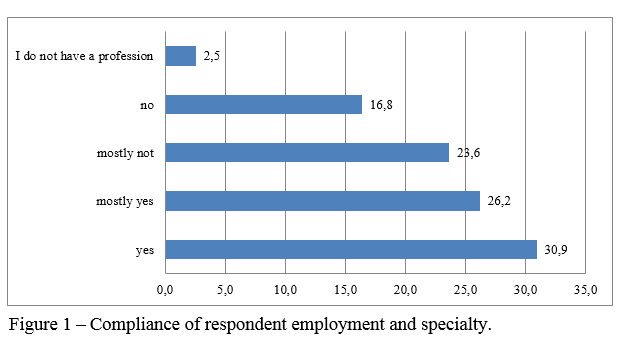
52% of young people who have professionally not corresponding jobs are females. This shows that both female and male are equally opposed to non-professional employment.
3. Opinions about working abroad
Certainly, the difficulty of finding a job corresponding to their profession makes young people try their luck abroad. Both employed and unemployed young people gave approximately the same answer to the question how they feel about working abroad. (fig. 2) It is pleasant to note that a large number of Armenian young people, even jobless, is not going to leave the homeland, and this circumstance is conditioned by Velvet revolution, which took place in 2018. As a result, young people have trust in the future, positive expectations, and aspirations to work and fulfill their dreams in their own homeland.
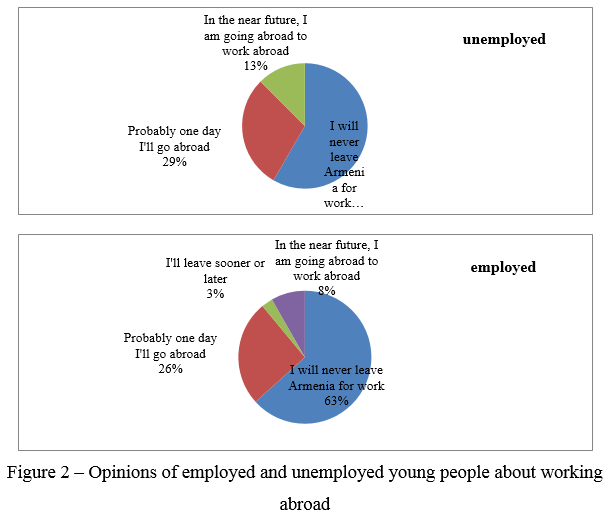
4. Opinion on fairness of the hiring process
The young people were also asked about the fairness of the hiring process. To understand how the status of a young person influences his attitude, let us present the degree of confidence of young employed and unemployed youth (fig. 3).
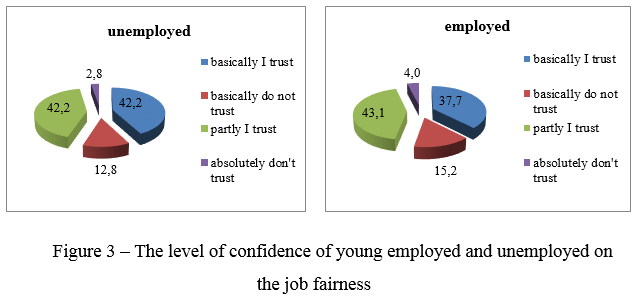
Figure 3 clearly shows that the difference of the rates of answers between employed and unemployed respondents is slight referring to the fairness of hiring, that is, the status of young people’s enthusiasm does not impact on their opinion on the fairness of employment, in addition, the confidence index is lower in both cases.
5. Opinion about employment discrimination
As to the reasons, 33.6% of unemployed young people stated that they did not encounter any discrimination, and 25.5% were convinced that hiring was possible only through mediation (fig. 4).
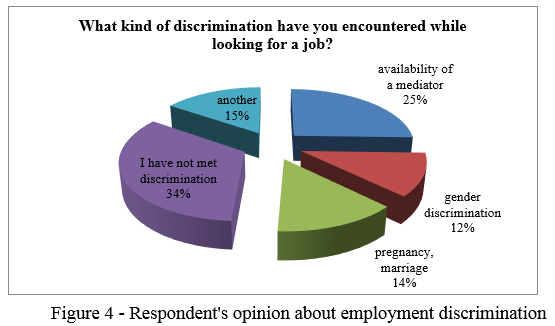
66% of young people who want to enter the labor market are already convinced that finding a job will be difficult and conditioned by some factors.
6. Factors that influence the decision-making process for applying
We have also recommended young people participating in the study to classify the organizational factors that influence the decision-making process for applying for a job so that we can further explore the motives behind the decision-making process. Cluster analysis has been carried out for this purpose. Thus, for the study of the structure of the factors influencing the decision-making on the respondent’s work, they were asked to assess the following conditions on the scale of the relevant priorities:
- the size of the organization,
- how long does the organization operate,
- the reputation of the organization,
- the amount of the salary,
- the nature of the work,
- working conditions,
- opportunities for professional growth,
- friendly staff,
- protection of labor rights,
- location.
As you can see, there are many variables that influence the decision-making process of young people, so in order to effectively organize the analytical work, we have first implemented a factor analysis that has allowed the large variables to be combined into smaller groups.
Prior to the factor analysis, we first checked the validity of our variables by using KMO and Bartlett testing for the factor analysis, according to which the KMO index is reaching 1 and Bartlett’s Testing Significance index does not exceed 0.05 (tab. 3).

By bringing out the optimal amount of factors from a large number of variables and considering the nature of reduced variables, we named the new factors, respectively, personal and image (fig. 5). With the help of the program, we can determine the level of their significance in the decision making process for each respondent by making cluster analysis. After analyzing the results of agglomeration, it was appropriate to classify respondents in 4 clusters.
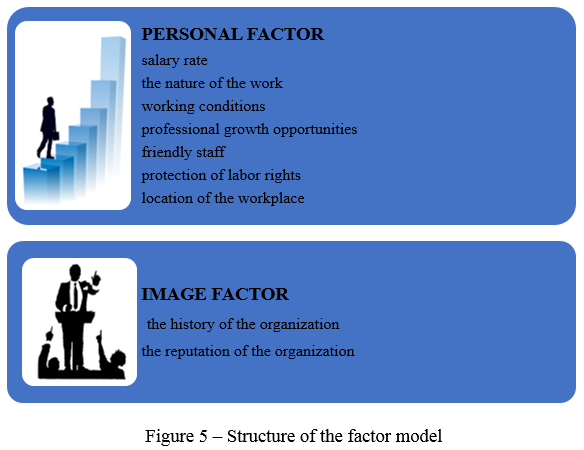
By calculating the number of respondents in each of the clusters as well as the average values of the components of the model (tab. 4), we have the following picture:
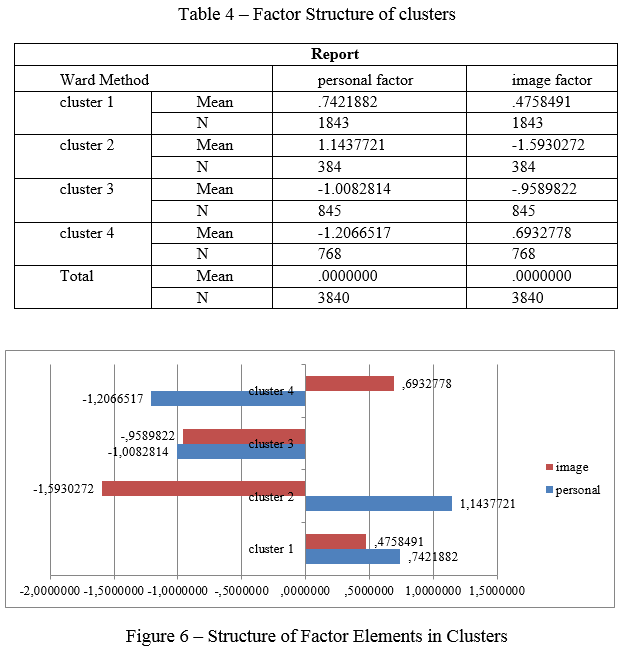
It should be noted that, according to the computerized analytical package13 applied, the components of the factor model range from -2 to +2, the higher the negative value of the new factor, the more important it is for the respondent and the higher the positive value, the less it is important for the respondent. Thus, Figure 6 shows those young people in Armenia have very different approaches to the importance of these factors. The first cluster shows young people who do not give importance to the two factors, the third shows young people who give importance to the two factors, the second cluster those, who give importance only to the image factor, and the fourth- only to the personal factor. There is a need to calculate the cluster size and the age structure of its respondents to understand the attitude of the majority (Figure 7 and Figure 8).
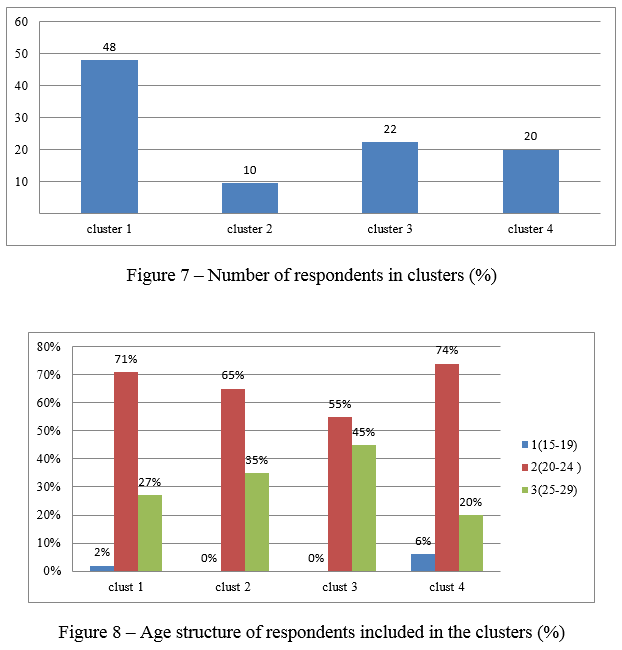
Figure 8 shows that 48% of the respondents are included in the first cluster. This is the «most favorable» cluster in which both factor components are not important. The main part here constitutes of the representatives of 20-24 age group (fig. 9), who mainly study and the majority of them are not married. In the third cluster, 22% of the respondents are involved, and they give significance to both personal and image factors. This cluster includes 55% of the 20-24 age group and 45% of the 25-29 age group respectively. The 20% respondents included in the 4th cluster emphasize personal factors, with a high percentage of the population aged 20-24 constituting the 74%. For the respondents of the second cluster, the personality factor has completely subdued its attributes to the image factor. This «romantic» cluster is the smallest, with 10% of the respondents involved.
It should be noted that in the second and third clusters there are no representatives of the 15-19 age group, which indicates that the image factor still does not affect them, and the personal factor is not important for the majority of them.
Conclusions
In recent decades the RA has been experiencing a sharp decline in employment and an increase in the unemployment rate. Therefore, radical reforms in the state policy in the sphere of labor market regulation are needed. Namely state aid and the promotion of youth potential are needed. Unfortunately, very often young people, having vocational education, become unemployed or are employed to work not according to their profession, as well as are ready to do any work to solve social problems. According to the survey, the largest percentage of those employed constitute the 20-24 year-old age group. In fact, it can be concluded that the employment rate of young people is higher in their student years, since they can occupy any position as far as they do not have a profession, while after graduation, not everyone is able to find a job according to his/her profession, which explains the low employment of young people aged 25-29. Moreover, the above-mentioned group is seeking rather for self-esteem, success and career.
Young people of the age group up to 19 show more intensive demand for professional knowledge and skills. The results of the survey also revealed that 42% of the youth surveyed in the RA are interested in personal factors, namely salary, job conditions, protection of their labor rights, etc. And only 32% gives importance to image factors — the reputation of the organization. According to the results of the survey, 48 per cent of the respondents were indifferent both to personal and image factors, which indicates that the state should develop and implement a unique complex of activities that will provide young people with not only employment guarantees, but will also provide their adaptation to the economic system of the modern society, will motivate in selecting a profession, and will further support the job placement appropriate to the qualifications, ensure internationally accepted standards of decent work. It is also a positive trend for the RA that 58% of unemployed young people have negative attitude towards working abroad, that is the confidence in the policy pursued by the state has been increased. Consequently, the state and the society should not passively follow the self-fulfillment of the youth labor market, but should develop and implement a program for effective youth employment regulation, as well as support and co-operation of state, local self-governing bodies, HEIs and other organizations for employing young people. One of the most effective means in the policy pursued by the state is the quota, which will oblige the employer to include some per centage of young people in his staff, contributing to the reduction of unemployment rate among young people.
References
- Employment. Statistical Yearbook of Armenia // Statistical Committee of the Republic Armenia. 2018. Pp. 52-87. [Электронный ресурс]. Режим доступа: https://www.armstat.am/file/doc/99510748.pdf
- Population and Labour market. Statistical Yearbook of Armenia // Statistical Committee of the Republic of Armenia. 2001. [Электронный ресурс]. Режим доступа: http://www.armstat.am/file/article/armenia-2.pdf
- Melkumyan, A. Labour Market, textbook, chapter 12. 2017. Pp 307-317.
- Рипская С.Г., Хохлова М.М. Проблема занятости молодежи и пути ее решения. [Электронный ресурс]: учебные материалы. Режим доступа: http://pravmisl.ru/index.php?id=1326&option=com_content&task=view
- Айдарова И.А. Проблемы трудоустройства молодежи на рынке труда // Гуманитарные научные исследования. 2014. № 6 [Электронный ресурс]. Режим доступа: http://human.snauka.ru/2014/06/7156
- Лисовский В.Т. Методология и методика изучения идеалов и жизненных планов молодежи: автореф. канд. дис. Л., 1968.
- Definition of youth. 2013. [Электронный ресурс]. Режим доступа: https://www.un.org/esa/socdev/documents/youth/fact-sheets/youth-definition.pdf
- Соколовский А.А. Проблемы занятости молодежи в современной России // Сибирский журнал науки и технологий. 2006. С. 130-132. [Электронный ресурс]. Режим доступа: https://cyberleninka.ru/article/v/problemy-zanyatosti-molodezhi-v-sovremennoy-rossii
- Шерер И.Н. Проблемы занятости молодежи на рынке труда // Известия ВГПУ. 2012. № 3 (67). С. 99-103. [Электронный ресурс]. Режим доступа: http://www.rusnauka.com/1_NIO_2012/Psihologia/14_98379.doc.htm
- Employment. Statistical Yearbook of Armenia // Statistical Committee of the Republic Armenia. 2017. Pp. 48-83. [Электронный ресурс]. Режим доступа: http://www.armstat.am/file/doc/99504348.pdf
- Law of the Republic of Armenia “On Employment”. Article 5, enforced in 11.12.2013. [Электронный ресурс]. Режим доступа: https://www.arlis.am/
- Долгова А., Жукова И. Полная и эффективная занятость молодежи – условие повышения конкурентоспособности страны // Человек и труд. 2007. № 8. С. 38-41. [Электронный ресурс]. Режим доступа: http://vmo.rgub.ru/policy/article.php?article_id=145
- Law of the Republic of Armenia “On Employment”. Article 7, enforced in 11.12.2013. [Электронный ресурс]. Режим доступа: https://www.arlis.am/
- Castillo M.D. Labour Force Framework: Concepts, Definitions, Issues and Classifications. [Электронный ресурс]. Режим доступа: https://www.ilo.org/wcmsp5/groups/public/—americas/—ro-lima/—sro-port_of_spain/documents/presentation/wcms_304686.pdf
- N 41 Statement from the RA Government Session on Approving the State Program and the List of Events on Employment Regulation for 2018, held on 28 September, 2017. [Электронный ресурс]. Режим доступа: https://www.gov.am/am/
- Population. Statistical Yearbook of Armenia // Statistical Committee of the Republic Armenia. 2017. Pp. 21-47. [Электронный ресурс]. Режим доступа: http://www.armstat.am/file/doc/99504343.pdf


